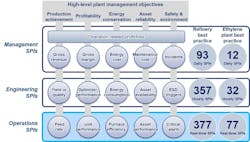Armed not only with more data but also better ways to make sense of that data, manufacturers are increasingly interested in helping their operators understand the business impact of the decisions they make on a day-to-day basis. Integrating IT with operational technology (OT) and domain knowledge, a new product from Yokogawa Electric is aimed squarely at that proficiency.
OpreX Profit-driven Operation is designed to help process industries align plant management objectives across the organization—from the operations floor through to the C-suite. Distilling interrelated performance indicators from Yokogawa’s domain knowledge, the system promotes profitability by helping to optimize the balance between conflicting objectives.
Siloed organizational structure and conflict among organizational units creates an environment where it is difficult to get true visibility across plants, according to Yasunori Kobayashi, manager of the Solution Development department within Yokogawa’s Premium Solutions and Service business headquarters. “The design of integrated, layered performance metrics from management to the front line required to solve this issue is not being done,” he said. “The visualization of performance metrics across all areas of the organization has not been achieved. Plant management are trialing systems from IT vendors that mainly deliver visualization, but because these companies do not have best practices regarding the design of performance metrics, these often fail to deliver.”
Though Profit-driven Operation is designed for all levels of the enterprise, there’s been particular interest at the operations level, Kobayashi noted. A new performance dashboard and related services are designed specifically for the operations level—integrated into the Centum distributed control system (DCS) to enable plant operators to monitor in real time how their operation patterns are impacting high-level plant management objectives. With services implemented at a plant, built-in expert advice is displayed any time an indicator moves outside of optimal setpoint range, prompting action from the operators. Yokogawa's "synaptic performance indicators" (SPIs) are accumulated along with operator performance data for internal and industry benchmarking, root cause analysis and expert consulting for continuous profitability gains.
SPIs—several hundred performance metrics used at the operation, engineering and management levels—are more useful than key performance indicators (KPIs) for operations, Kobayashi indicated. “KPIs are high-level aggregations directly connected to a plant’s profit and loss, so cannot be used by the operations level for digging into and identifying the causes of falling performance,” he explained.
This gets directly at an issue that has kept executive objectives from being understood at the operations level. “High-level management objectives have not been visualized or made available to the operations level in an accessible way, so they prioritize and are motivated by the operations and production indicators that directly show the outcome of their operating patterns, instead of by management objectives, causing a disconnect,” Kobayashi said.
Yokogawa’s 2016 acquisition of KBC Advanced Technologies, which specializes in consulting and simulation for energy and chemical industries, was a key factor behind the ability to bring all of the capabilities together into the Profit-driven Operation offering. Specifically, it combines Yokogawa’s expertise in industrial automation technologies with the extensive domain knowledge of experts at KBC. Yokogawa collaborated closely with KBC industry consultants to first define and then systematically structure the SPIs based on deep knowledge of how they affect plant performance.
Profit-driven Operation is the second product release to come out of the KBC acquisition, the first being the KBC Co-Pilot Program, released early last year. The cloud-based performance improvement tool—which displays engineering and management-level SPIs, and remotely supports assets with domain expertise and insight—is included as part of the Profit-driven Operation suite.
Profit-driven Operation is the first to be given the OpreX brandname, which will include all of Yokogawa’s industrial automation products and services going forward. It is also a flagship product for Yokogawa’s Synaptic Business Automation concept.
The system has already been optimized for oil refining and petrochemicals, and Yokogawa intends to expand its application to LNG and basic chemical plants in the near future.
“Plants for continuous bulk processes have segmented organizations and large numbers of workers, so the needs for this type of solution are high,” Kobayashi said. “We have already standardized the know-how for designing the performance metrics framework, and this can be applied to any process industry.” The SPIs, however, vary by application based on the specific processes and equipment used, he added. “We are still optimizing these for the LNG and chemicals applications.”
Yokogawa is working with several customers to introduce Profit-driven Operations during October 2018, Kobayashi said. The company plans to accept LNG enquiries after delivery of that solution begins in January 2019. “For chemicals, we are now in the process of selecting processes with the highest needs,” he added. “We have already identified ethylene and aromatics as having high needs, so are prioritizing those.”
Leaders relevant to this article:

